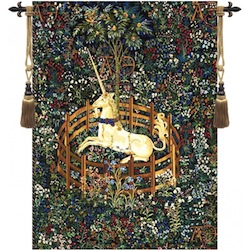Tell Significantly Important Stories
Most evidence points to the Unicorn Tapestries having their beginnings in or around the 15th century. Perhaps two of the most well known works related to unicorn textile art are The Lady And The Unicorn and the Hunt for The Unicorn. Both of these masterfully crafted art pieces provide detailed imagery that is symbolic of high quality textile art that was used to make historical records of the middle ages. In many instances, tapestries were used in ancient times to cover the walls of manors and castles in order to maintain warmth throughout the structure. In addition to keeping the nobility warm and comfortable, tapestries were also used to tell significantly important stories to the masses. Because most people of the time were largely illiterate, tapestries served an important story telling purpose.
The Highest Quality Textile Products In The World
From family crests to important history markers, tapestries have been used throughout the ages for a variety of important purposes. Even churches of days gone by used textile art to convey biblical events and stories of significant value. In other instances, tapestry art has been used to highlight national allegiance. Many scholars trace a variety of early tapestries back to ancient Greece. However, in more recent history it was Belgium and France that had manufactured some of the highest quality textile products in the world. Many tapestry aficionados are dismayed by the fact that a large number of historical significant tapestries were destroyed over the course of the French Revolution. Much of this destruction was motivated by the desire to extract interwoven gold threading within the tapestry fabric.
The Unicorn Is Ultimately Resurrected
With regard to the historical significance of the unicorn tapestries such as “The Hunt For The Unicorn,” there are many interpretations assigned to these quality pieces. The first piece in the unicorn series simply displays in vibrant color the hunters with no sign of a unicorn. In the second piece the unicorn can be seen in the same scene with the hunters. Ultimately the unicorn is portrayed defending itself from the aggressive hunters. In one of the final tapestry pieces the unicorn ultimately meets its demise. However, in the final tapestry the unicorn is ultimately resurrected. This series of events has caused many to interpret the unicorn tapestries as representing the history of Christ. Many theories go on to suggest that “The Lady And The Unicorn” is representative of the Virgin Mary. In many respects, this final unicorn tapestry symbolizes purity and innocence. The unicorn tapestries are a testament to the historical significance of textile art.
About The Website
Considered to be one of the most important wall art and wall tapestry websites online today, Save On Tapestries provides those in search of quality textile art a comprehensive selection of beautiful pieces to choose from 24 hours a day. Visit SaveOnTapestries.com.

